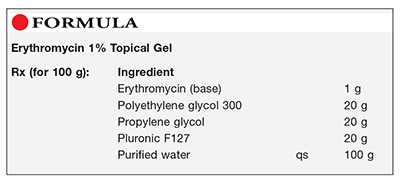US Pharm. 2017;42(4):46-47.

Method of Preparation: Calculate the quantity of each ingredient for the amount to be prepared. Accurately weigh or measure each ingredient. Mix the erythromycin with the polyethylene glycol 300 and propylene glycol, and heat the mixture to 70°C. Incorporate the Pluronic F127 and mix until dissolved. Remove the mixture from heat, add sufficient purified water to final weight, and mix well. Permit any air bubbles to escape and allow the preparation to cool. Package and label.
Use: Erythromycin 1% gel is used as a topical anti-infective.
Packaging: Package in tubes or in push-up ointment containers.
Labeling: Keep out of reach of children. Keep refrigerated. For external use. Discard after ____ [time period].
Stability: A beyond-use date of up to 30 days may be used for this preparation.1
Quality Control: Quality-control assessment can include theoretical weight compared with actual weight, pH, specific gravity, active drug assay, color, texture–surface, texture–spatula spread, appearance, feel, rheologic properties, and physical observations.2
Discussion: When counseling the patient concerning this preparation, it is advisable to explain its temperature-dependent viscosity. As the preparation is rubbed into the skin and warms up, it may become slightly more viscous and resistant to rubbing.
Erythromycin (C37H67NO13, MW 733.93) occurs as a white or slightly yellow, crystalline powder that is odorless or practically odorless. It is slightly soluble in water and soluble in alcohol. Erythromycin is a macrolide antibiotic, and it is active principally against gram-positive cocci and bacilli, as well as—to a lesser extent—gram-negative cocci and bacilli. It is also active against Chlamydia, Mycoplasma, Ureaplasma, spirochetes, and mycobacteria.1
Polyethylene glycol 300 (Carbowax, PEG, polyoxyethylene glycol) is an addition polymer of ethylene oxide and water. It occurs as a clear, colorless, or slightly yellow-colored, viscous liquid with a slight but characteristic odor and a bitter, slightly burning taste. This substance has a density in the range of 1.11 g/mL to 1.14 g/mL, and its freezing point is –15°C to –8°C. Polyethylene glycol is miscible with water and in all ratios with other polyethylene glycols. It is also soluble in acetone, alcohols, glycerin, and glycols.3
Propylene glycol (C3H8O2) occurs as a clear, colorless, viscous, practically odorless liquid with a sweet taste somewhat resembling glycerin. It has a specific gravity of 1.038 g/mL, and it is miscible with acetone, chloroform, 95% ethanol, glycerin, and water. Propylene glycol is used as a humectant and solvent in topicals. Propylene glycol is actually a better solvent than glycerin and is similar to ethanol as an antiseptic. It is stable and may be mixed with numerous other solvents.4
Pluronic F127, a block copolymer of ethylene oxide and propylene oxide, is used as an emulsifying, solubilizing, wetting, and gelling agent. The pH of a 2.5% w/v aqueous solution is in the range of 6.0 to 7.4. Pluronic F127 is stable, and aqueous solutions are stable in the presence of acids, alkalis, and metal ions; the aqueous solutions support mold growth, however. Poloxamer 407 (Pluronic F127) is generally available in powdered form. It either is odorless or has a very mild odor. Pluronic F127 melts at about 56°C, and it is freely soluble in water, alcohol, and isopropyl alcohol.5
Purified water is water that is obtained by distillation, ion exchange, reverse osmosis, or some other suitable process. Water has a specific gravity of 0.9971 at room temperature, a melting point of 0°C, and a boiling point of 100°C. It is miscible with most polar solvents, and it is chemically stable in all physical states (ice, liquid, and steam).6
REFERENCES
1. U.S. Pharmacopeia/National Formulary [current revision]. Rockville, MD: U.S. Pharmacopeial Convention, Inc; March 2017.
2. Allen LV Jr. Standard operating procedure for performing physical quality assessment of ointments/creams/gels. IJPC. 1998;2:308-309.
3. Wallick D. Polyethylene glycol. In: Rowe RC, Sheskey PJ, Quinn ME, eds. Handbook of Pharmaceutical Excipients. 6th ed. Washington, DC: American Pharmaceutical Association; 2009:517-522.
4. Ladyzhynsky NS. Propylene glycol. In: Rowe RC, Sheskey PJ, Cook WG, Fenton ME, eds. Handbook of Pharmaceutical Excipients. 7th ed. Washington, DC: American Pharmaceutical Association; 2012:672-674.
5. Cable CG. Poloxamer. In: Rowe RC, Sheskey PJ, Cook WG, Fenton ME, eds. Handbook of Pharmaceutical Excipients. 7th ed. Washington, DC: American Pharmaceutical Association; 2012:573-577.
6. Dubash D, Shah U. Water. In: Rowe RC, Sheskey PJ, Cook WG, Fenton ME, eds. Handbook of Pharmaceutical Excipients. 7th ed. Washington, DC: American Pharmaceutical Association; 2012:880-884.
To comment on this article, contact rdavidson@uspharmacist.com.






